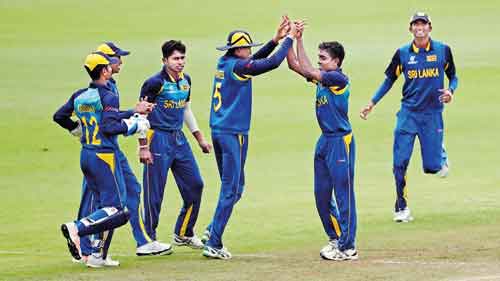Are we serious about winning an Under-19 World Cup?
View(s):- Looking ahead after the debacle
- National Chief Selector feels it’s high time we got serious with our junior cricket
 Lankan cricket, after almost two years of running in the wilderness, is now looking to break its shackles, and come out as the unit they are expected to be. But, to do so, they need people of the calibre of former national paceman Graeme Labrooy, who does not mind spending his time to learn what’s going around and where the real faults lie. This is an area confined to experts who are trying to find out how to sustain Lankan cricket, in the manner that brought success to countries such as India and England – I mean cricket from the level of Under (U)-19 – where the graduation process begins.
Lankan cricket, after almost two years of running in the wilderness, is now looking to break its shackles, and come out as the unit they are expected to be. But, to do so, they need people of the calibre of former national paceman Graeme Labrooy, who does not mind spending his time to learn what’s going around and where the real faults lie. This is an area confined to experts who are trying to find out how to sustain Lankan cricket, in the manner that brought success to countries such as India and England – I mean cricket from the level of Under (U)-19 – where the graduation process begins.Labrooy was there through the proceedings of the recent Lankan U-19 cricket debacle at the U-19 World Cup (WC). Though Sri Lanka managed to win the plate championship, Labrooy took this as a case study to explore ways and means to turn the wheel of fortune and elevate the Lankan U-19 Cricket to be on par with the rest of the junior giants.
Labrooy, indeed, is using the nuts and the bolts. He is working closely with national Coach Chandika Hathurusinghe who has taken up the challenge to turn things around.
When the Sunday Times Musings contacted him, Labrooy began his narration in this manner, “In most of the top notch cricketing nations, the preparations for the U-19 WC begins almost 18 months prior to the event, and they start working backwards. They look at what the cut off is. There they pick an U-17 squad who would then become eligible to play in the next U-19 WC tournament, and work with that squad.
“For instance, if you are to play against England in an U-19 series in December this year, what they get in England is an U-17 outfit in preparation. There would be one or two outstanding U-19 players who would be in the mix, just to motivate them, but the majority would be U-17 players. About a year ago, a Sri Lanka U-19 team toured England and thrashed them. Avishka Fernando got two centuries in that series. There, we played the England U-17 team. The difference was that, it was our U-19 team, while England was preparing for the next World Cup. From the team that made that WC tour of England, only two boys remained to play in the U-19 WC for Sri Lanka. But, for England, the entire squad was there. That was how England prepared for the U-19 tournament.”
Labrooy thinks we have to change this norm. He said they learned that some countries even sent 4-5 prospective players well ahead to New Zealand to play club cricket. The lads had stayed with families and, at the same time, made sure they were engaged in cricket. Ireland, for instance, had sent some players to New Zealand and got them to play cricket, while staying with some Irish families. “Our cricket structure is the best in the world, but whether we are preparing for the U-19 WC is another question.”
 At this stage, we pointed out that India tries out a host of U-19 players in the Ranji Trophy matches. He said, “In the Asia Cup, those guys were not picked. They were allowed to continue with their Ranji Trophy Cricket. In Malaysia, India were not interested in winning the Asia Cup – their sights were on the WC. Indian U-19 coach Rahul Dravid held back some of the top players from that tournament. They wanted to test some players and fathom their capabilities – they were sent for the Asia Cup.
At this stage, we pointed out that India tries out a host of U-19 players in the Ranji Trophy matches. He said, “In the Asia Cup, those guys were not picked. They were allowed to continue with their Ranji Trophy Cricket. In Malaysia, India were not interested in winning the Asia Cup – their sights were on the WC. Indian U-19 coach Rahul Dravid held back some of the top players from that tournament. They wanted to test some players and fathom their capabilities – they were sent for the Asia Cup.
“Once they got back, they invited us to play a series in India. They played six matches. There, the boys playing in the Ranji Trophy, played against us. If we send our U-19 boys to play club matches, there would be lot of red tape and questions asked. U-19 boys are not even sent freely to train at Kettarama, if there are school matches. Principals, masters-in-charge and coaches are up in arms. The SLC support staff training the squad for the WC, get boys only two days a week, only for the last six months. Only during the last one-and-a-half months or so, they get about four days a week training. These are some of the drawbacks within this system in the preparation for a tournament of that magnitude.”
Citing a personal example, Labrooy said that as a schoolboy cricketer, back in the 1980s, he had bowled to Roy Dias and Duleep Mendis at the NCC nets. “Rumesh Ratnayake, Ravin Wickremaratne and I were working with the National pool at that time. Now, if we are to do that, there would be reams of red tape. These are little things we have to iron out. Yet, again I ask, in spite of having the best school cricket structure, whether it is serving the purpose. We need players preparing for the next stage of our cricket.”
“The boys who went on the WC tour, lost their confidence. We failed to qualify for the second round. That scar, they carry forward in their careers. We must keep thinking long term, when it comes to this segment of the game.”
The other situation that Labrooy pointed out was the preparation of junior cricket. He said, when they were at U-14 and then U-15 level, they played with the 4½ oz ball on a 20-yard wicket. Now, he finds they are playing U-15 under senior norms — 22 yards and 5½ oz ball. “The result is, we are not producing spinners. The ball is too big for the youngster to grip. Even if they tried, they only could roll the ball. More often, they were off-spinners and hardly any wrist spinners. We Asians are small in stature; therefore we have to play a sharper brand of cricket. This request has gone to the authorities before, but the change is not forthcoming,”he said.
Then Labrooy tackled another thorny issue. “The cricket that is being played is diluted. Something similar to club cricket. We have quantity, but no quality. We find the No.1 side in the school arena, plays a match against the 40th ranked team. We feel that No.1 should go down only to about the 15-20, at the most. At the same time, as a result of the schools cricket tournament, they have opted for quantity rather than quality. My question is whether we really want to win an ICC U-19 WC,” Labrooy said.
He, however, beleives schools cricket should be without tournaments. “Winning an U-19 tournament means you are preparing cricketers for the future. If you are constantly going to end up at the bottom rung in the U-19 tournaments, there is something wrong with our preparations for the future. Just imagine, only once we entered the final of the U-19 WC, and there too, the tournament was played here in Sri Lanka in 2000.”
Nevertheless, Labrooy added that, the brand of cricket we play is good. He said, “Player for player, we are good. In Australia, besides one leg-spinner, the best of the others looked quite ordinary. The same goes with England. When you look at our fast bowler Nipun Malinga, he has everything going for fast bowling. Besides some fast bowlers in Afghanistan, Pakistan and India, our cricketers are in there. But, when it comes to competitions, we fall short. We do not prepare our cricketers for the next step in international cricket.”
Then we asked, what about cricketers who did a lot of scoring in this schools tournament this season, but failed to make it to the tournament. Labrooy said, “There is a difference in the quality of cricket being played in the ICC U-19 tournament, and our school cricket competition. Though players like Raven Kelly came within that scope, he failed to make it because of fitness.”
But, the Selection Committee Chairman is rather disturbed about the fact that, we are not choosing the right cue when it comes to the batsmen at this level. From the lot he has seen, right now there are only five cricketers who would make it to the international level in time to come, besides late developers. The five players are Kamindu Mendis– all-rounder, decent bat and extraordinary, as he bowls with both arms; Ashen Bandara– top flight striker, good fielder and bowls leg-spin (wrist spin); Nipun Malinga- seam bowler with potential, still 17 and has to be worked on; Rasika Dilshan– a left arm spinner from Trinity College; and Josephian Jehan Daniels– another Angelo Mathews in the making, who can hit 140 km anytime he wants.
However, Labrooy also said that Coach Hathurusinghe feels that T-20 cricket is designed for the younger folk and is keen to see some of those U-19 cricketers making the grade through the U-20 but, ironically, there is a ban on U-19 cricketers taking part in cricket in that part of the woods. “In fact, we had identified three cricketers to be drafted into the Nidahas Trophy pool of 25, but SLC authorities advised against it, saying there is a ban on U-19 players taking part in that segment of the game. We are in the process of appealing through the SLC President to overcome the hurdle.”


